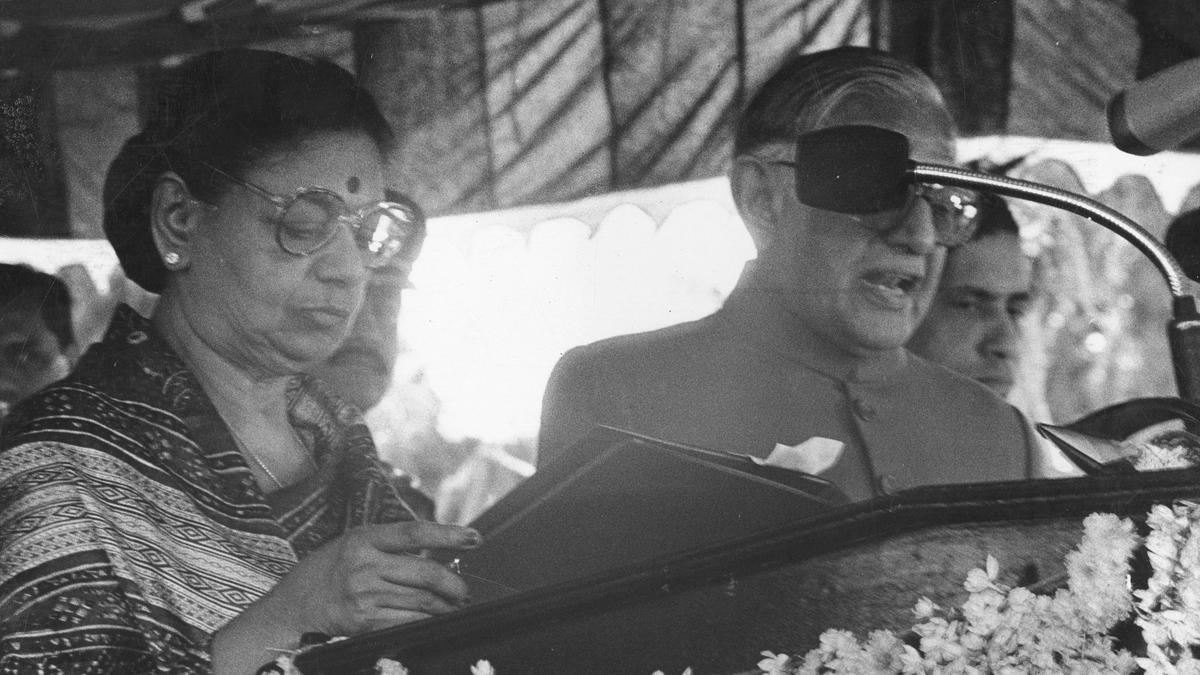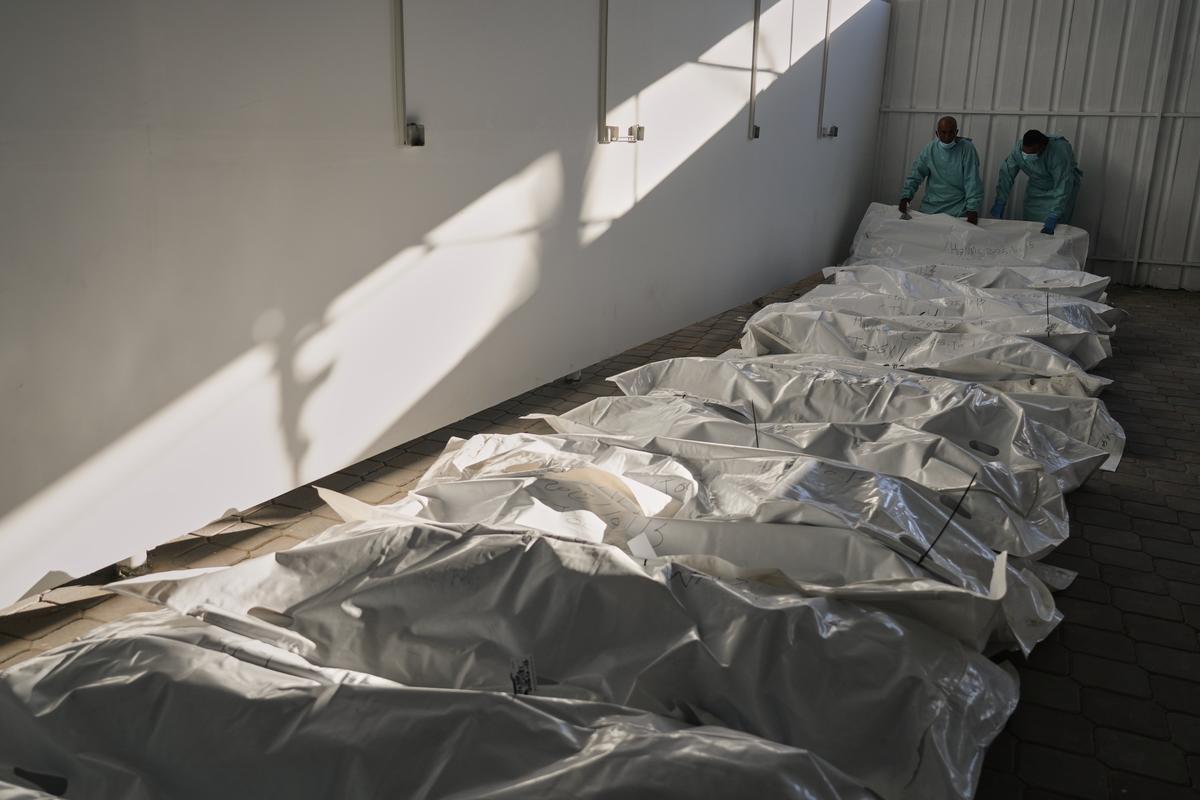Looking back at the events immediately after former Chief Minister and All India Anna Dravida Munnetra Kazhagam (AIADMK) founder M.G. Ramachandran’s (MGR) demise in December 1987, veteran politician ‘Panruti’ S. Ramachandran recalls that it was Janaki Ramachandran who decided on her own to succeed her husband who was the Chief Minister of Tamil Nadu from 1977 to 1987.
Any discussion on the current state of affairs in the AIADMK invariably witnesses references to the brief stint in politics of Ms. Janaki.
The episode was highlighted during recent interviews given by prominent personalities to certain social media channels. Industrialist Palani G. Periasamy spoke of the circumstances in which MGR died on December 24, 1987, and how Ms. Janaki succeeded him.
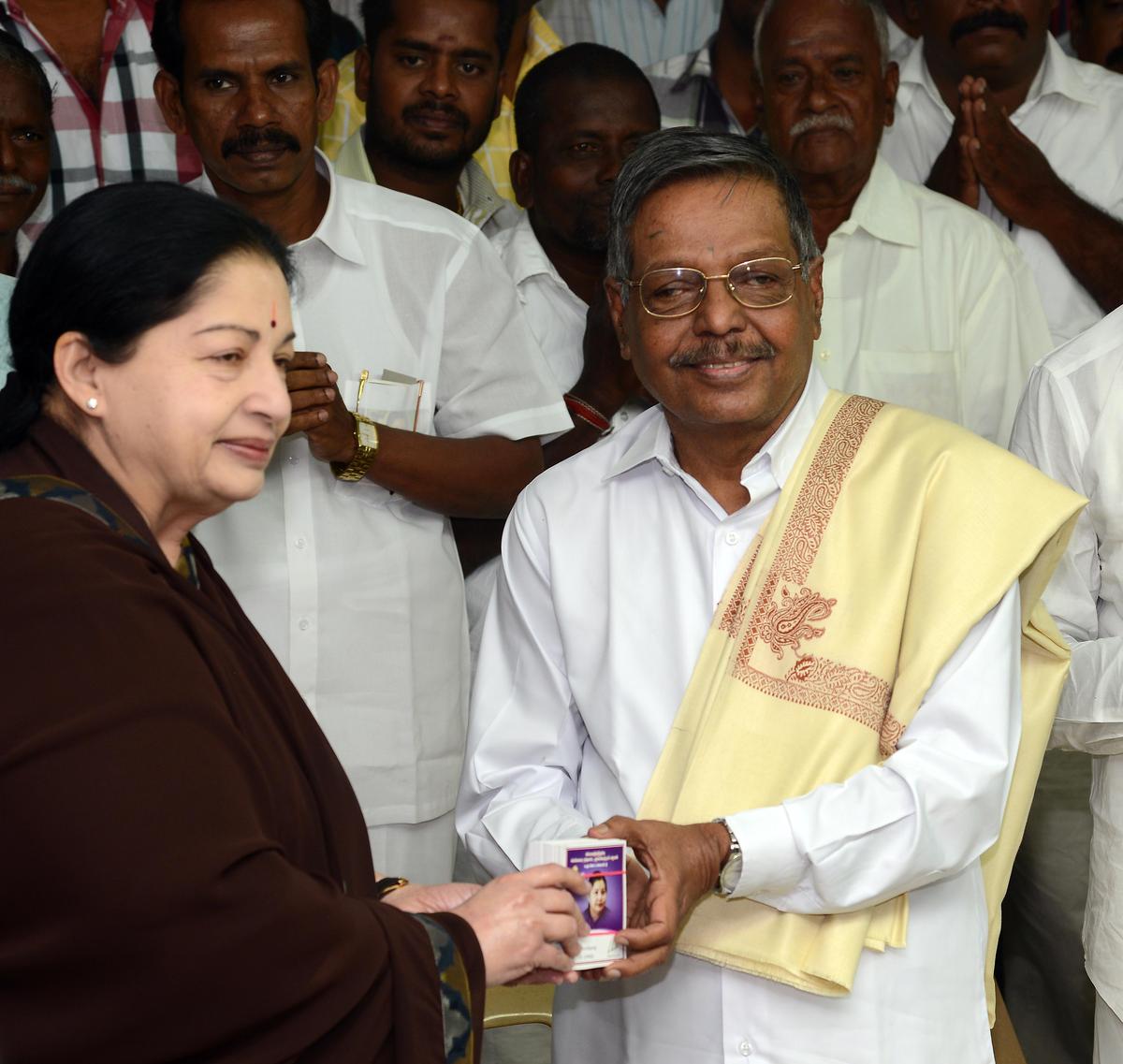
‘Panruti’ S. Ramachandran with J. Jayalalithaa at the AIADMK headquarters in Chennai. File
| Photo Credit:
K.V. Srinivasan
Mr. Periasamy recalls that two days after MGR’s demise, he was surprised when Ms. Janaki informed him that she was going to become the Chief Minister. Ms. Janaki conveyed she had been “greeted” by ‘Panruti’ Ramachandran, ranked third in the MGR Cabinet, who held portfolios such as Electricity and Food.
Congress’ former law-maker and ex-chief of the Tamil Nadu Minorities Commission S. Peter Alphonse mentioned about the then President of India R. Venkataraman’s advice to a Congress delegation on the rationale behind supporting the short-lived council of ministers led by Ms. Janaki. Not oblivious to her health and age, the President had told the delegation to impress upon the Congress to support her instead of much younger Jayalalithaa (then spelt as Jayalalitha), who had then aspired to make it to the top in the AIADMK.

Admitting that he and his wife met Ms. Janaki, Mr. Ramachandran, in a conversation with this correspondent, however denies the suggestion that the purpose of his call was to congratulate her. “After MGR’s funeral, we went there [Ramavaram Gardens, the residence of the former Chief Minister] to convey our moral support to her. But, when she told me she had decided to succeed her husband as the Chief Minister, I had the shock of my life,” Mr. Ramachandran recalls. The occasion was such that he did not say anything before taking leave of her.
As a temporary measure, Mr. Ramachandran favoured the idea of letting the ‘acting’ Chief Minister V.R. Nedunchezhian to continue with all the Ministers that MGR had at the time of his death. At that time, another senior Minister R.M. Veerappan (RMV) too had nursed the ambition of becoming Chief Minister.
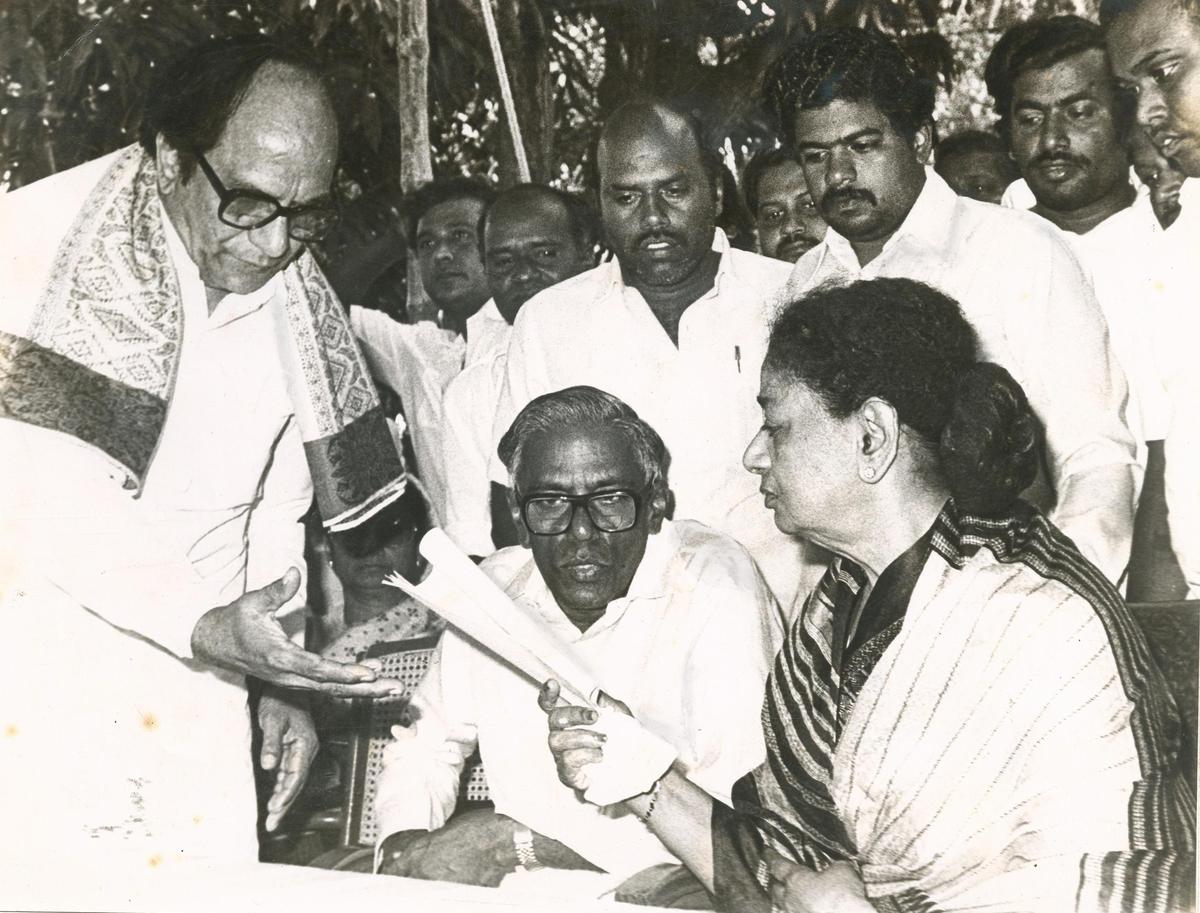
Janaki Ramachandran handing over to P.U. Shanmugham, then Health Minister, a statement announcing her decision to become the Chief Minister, on December 31, 1987. Also seen is R.M. Veerappan (seated on her right), Local Administration Minister.
| Photo Credit:
The Hindu Archives
“A group owing allegiance to Mr. Veerappan was under the impression that I was also in the race,” the former Electricity Minister says, adding he had the support of Ministers such as Su. Thirunavukkarasar (then S. Thirunavukkarasu) and K.K.S.S.R. Ramachandran (now a Minister in the DMK government).

Jayalalithaa was a key member of the group that wanted Nedunchezhian to become the Chief Minister. It was no wonder that the group had later declared her as the party’s general secretary. When Ms. Janaki was sworn in as the Chief Minister on January 7, 1988, Mr. Ramachandran was not in her Cabinet.
The veteran leader observes that even in 1984 when MGR was hospitalised in the U.S., the AIADMK’s nominees for the Assembly election were finalised by Ms. Janaki and Mr. Veerappan, a point that a couple of others do not agree with. J.C.D. Prabhakar, Villivakkam’s former MLA, who contested unsuccessfully in the 1984 Assembly poll; R. Kannan, who authored the biographies of C.N. Annadurai and MGR, and an aide of MGR at the Chief Minister’s office, deny this point. They, however, agree that RMV had played a huge role in the selection of candidates.
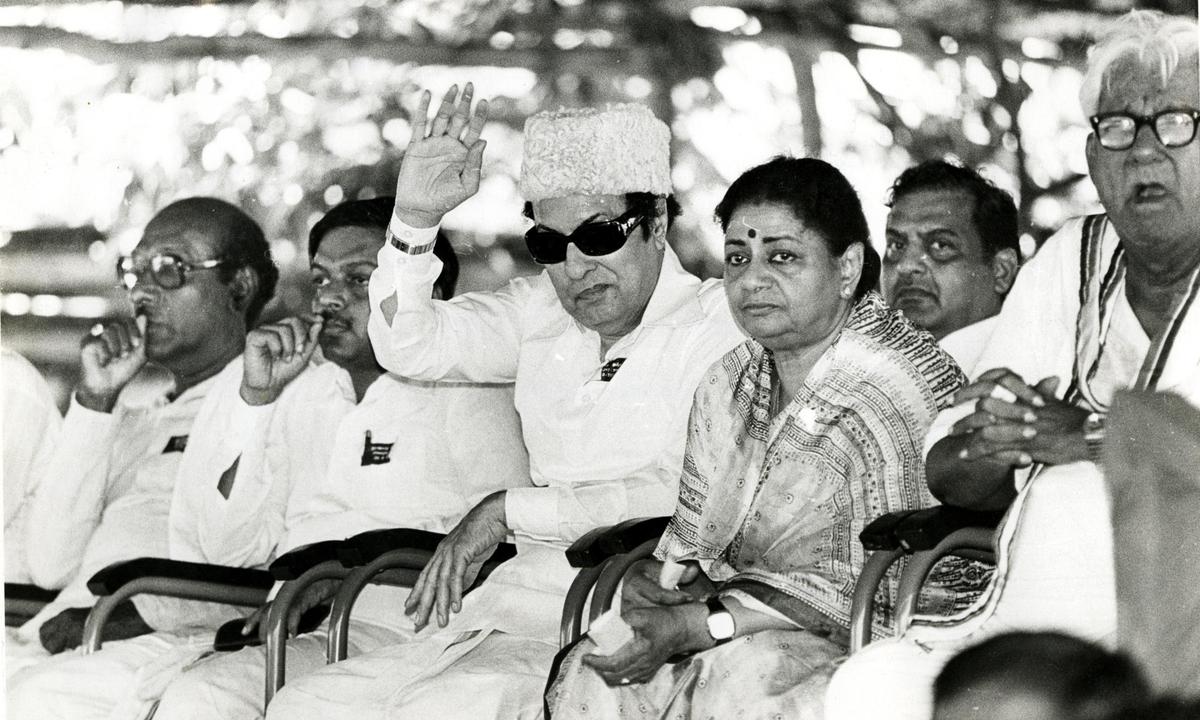
Then Tamil Nadu Chief Minister M.G. Ramachandran with his wife Janaki in Madras on September 24, 1985.
| Photo Credit:
The Hindu Archives
A high-powered panel, which had consisted of senior Ministers, had formally zeroed in on the candidates. Mr. Prabhakar, who was the then undivided Chengalpattu district secretary of the party covering 17 Assembly constituencies, however, says most of the district secretaries were “RMV’s men.” When they were interviewed by the panel, they had naturally promoted RMV’s proteges. “This was why 90-odd MLAs [out of 131] were with Ms. Janaki when the confidence motion was taken in January 1988,” he points out.
The former legislator, who sided with Ms. Janaki’s faction in 1988 and contested again in Villivakkam during the 1989 Assembly elections only to lose, asserts that if she had really involved herself in the party ticket distribution in 1984, she would not have opted to retire from politics soon after the 1989 Assembly polls.” In fact, during the merger after the 1989 polls, she was offered the post of chairperson of the party presidium but she declined,” recalls Mr. Prabhakar, who was elected from Villivakkam for a second term.
Ms. Janaki remained unmoved despite her former bête noire Jayalalithaa’s appeal to her to reconsider her decision to quit politics.
Though the aide recounts that MGR’s many well wishers had advised Ms. Janaki not to take the plunge into politics, he suspects she had come to the conclusion of herself becoming the Chief Minister, after she had a one-to-one meeting with a senior office bearer of the Congress who hailed from north India. Venkataraman, in his “My Presidential Years,” records that Ms. Janaki was “initially reluctant to take up the leadership but was persuaded when cautioned that her rival, Jayalalitha[a], might take control of the party if she did not agree.”
A publication on the MGR’s widow, brought out by her grandnephew Kumar Rajendran in 2019, carries an interview of hers in March 1988 to a Tamil journal Kalki, in which she had stated that she had joined politics only to ensure unity in the party. In fact, the “unity card” was played by her even before becoming the Chief Minister. In a statement on the eve of taking charge, Ms. Janaki, in a statement, appealed to all the 131 AIADMK MLAs to “bury the hatchet”, forget their differences, and rally round and extend their whole-hearted support and cooperation to her, according to a news report of The Hindu on January 7.
Janaki Ramachandran, widow of the former Chief Minister of Tamil Nadu, M.G. Ramachandran
| Photo Credit:
The Hindu Archives
She had accepted the plea of party cadre to bear the burden of the Government on her shoulders “in the interest of maintaining unity” and to prevent the organisation founded by MGR from disintegrating, the report added.
However, even in 1986, there were whispers of interference from Ms. Janaki and other members of MGR’s family. They grew so loud that “the government ran two paid advertisements in the chief minister’s name in June. The first, issued on 13 June, directed civil servants not to oblige his wife or other close relatives vis-à-vis official matters. Apparently, a police constable owed his appointment to Janaki,” writes Dr. Kannan in his book “MGR: A Life.”
The Janaki regime, which lasted 24 days, was dismissed after the Assembly witnessed pandemonium on the day of confidence motion on January 28, 1988. She remained in politics for one year. When she lost miserably during the 1989 Assembly poll in Andipatti, a constituency her husband represented during 1984-87, she realised she was not cut out for electoral politics. Her announcement of quitting politics was out on January 31, 1989, within days of the declaration of the poll results.
